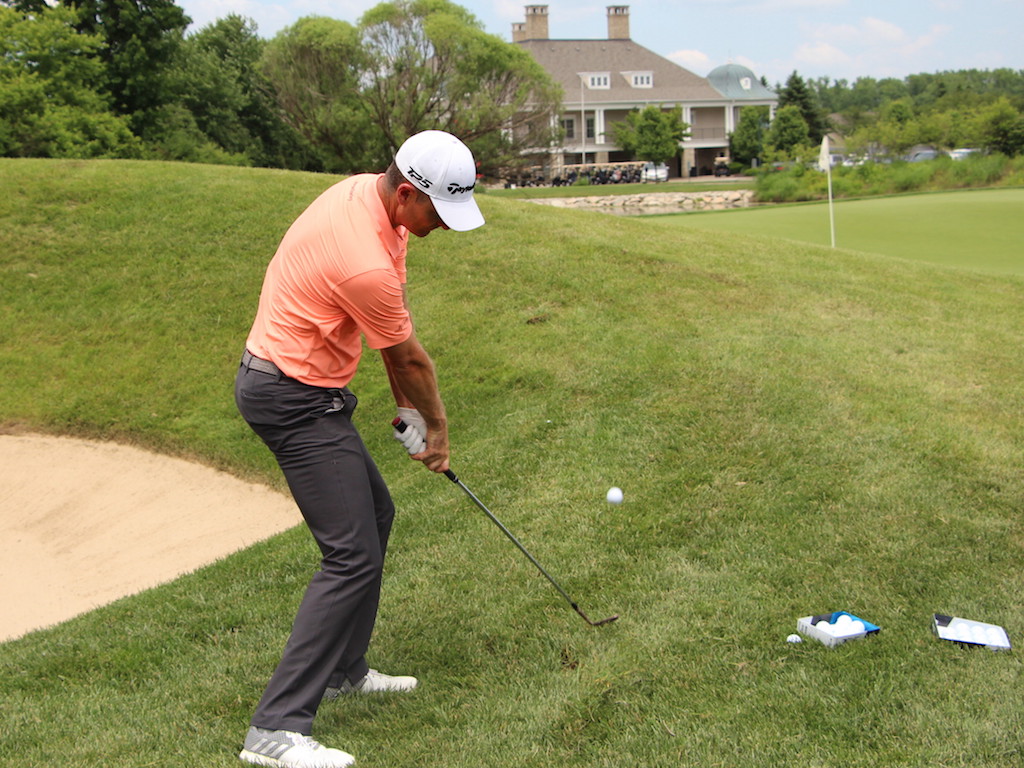Instruction
The Wedge Guy: Which is better – method or feel?

I had an interesting conversation last week about the best way to approach your short-range scoring shots that require something less than a full swing. The golfer I was visiting with was conflicted by things he had read by various instructors regarding approaching these shots with a concise and repeatable “method” versus other instructors who he felt advised that you just have to develop feel for this part of the game.
My take is that you have to have both in order to score better.
There’s no question that the more “methodized” you can make your approach to the in-between and less-than-full shots, the more consistent you will become. But there are varying degrees of “methodization” that you can build in, and each degree requires a commitment to learning and practice time. The question you must ask yourself — and be honest with the answer — is how much time will you really give it?
For recreational golfers, I think the best approach to start with is to work on learning a basic “half-swing.” To me, that is where the left arm (for RH players) goes back only to where it is parallel to the ground. You want good extension back, and almost a full shoulder turn at this shortened end-of-backswing position. From there, make a rhythmic and smooth turn and pull through the impact zone, and into a 3/4 finish. This is not about power, but rather repeatable swing length and speed, so that you get consistent results.
Once you learn this half-swing, experiment hitting shots with all your wedges and maybe even your 9-iron, to see what distances you get with each and what kind of ball flight and release each club delivers. With this simple exercise, you now have 4-5 new dialed-in distances and ball flights to take to the course.
Now, let’s apply feel to the formula. I like to think of feel as it relates to my swing speed, which is ideally governed by the speed of my body core rotation. Going back to that half swing and those new shots you learned, now you can apply three speeds that we’ll relate to driving our cars. I call them “Country Road,” “City,” and “School Zone.”
“Country Road” is what you just learned as “full speed” for this “half wedge shot” . . . not too powerful, very controlled. Less than the speed of a full-swing 7-iron shot for sure.
“City” is throttled back from that to a more relaxed speed – more precise, more cautious. It will produce a distance result with each club that is measurably less than your Country Road speed, giving you another batch of distances you can dial in.
Finally, I like to think of “School Zone” on my shorter pitch shots around the greens and my bunker play. It’s very relaxed and deliberate, almost “lazy.” If you will learn to swing at this speed with various clubs, you’ll have a whole new arsenal of scoring shots to call on. A great practice routine is to actually see how slow you can swing. You’ll find that you can move the club in virtual slow motion, and still hit a quality shot.
It’s fun to learn new ways of striking the ball, and I hope this exercise gives all of you new shots to learn and perfect to improve your scoring.
Related
- The Wedge Guy: Your game vs. the pros
- The Wedge Guy: More on learning the grip
- The Wedge Guy: It’s a game, right? So have fun!
- LIKE78
- LEGIT7
- WOW2
- LOL2
- IDHT2
- FLOP17
- OB5
- SHANK14
Instruction
Clement: Laid-off or perfect fade? Across-the-line or perfect draw?

Some call the image on the left laid off, but if you are hitting a fade, this could be a perfect backswing for it! Same for across the line for a draw! Stop racking your brain with perceived mistakes and simply match backswing to shot shape!
- LIKE0
- LEGIT0
- WOW0
- LOL0
- IDHT0
- FLOP0
- OB0
- SHANK1
Instruction
The Wedge Guy: The easiest-to-learn golf basic

My golf learning began with this simple fact – if you don’t have a fundamentally sound hold on the golf club, it is practically impossible for your body to execute a fundamentally sound golf swing. I’m still a big believer that the golf swing is much easier to execute if you begin with the proper hold on the club.
As you might imagine, I come into contact with hundreds of golfers of all skill levels. And it is very rare to see a good player with a bad hold on the golf club. There are some exceptions, for sure, but they are very few and very far between, and they typically have beat so many balls with their poor grip that they’ve found a way to work around it.
The reality of biophysics is that the body moves only in certain ways – and the particulars of the way you hold the golf club can totally prevent a sound swing motion that allows the club to release properly through the impact zone. The wonderful thing is that anyone can learn how to put a fundamentally sound hold on the golf club, and you can practice it anywhere your hands are not otherwise engaged, like watching TV or just sitting and relaxing.
Whether you prefer an overlap, interlock or full-finger (not baseball!) grip on the club, the same fundamentals apply. Here are the major grip faults I see most often, in the order of the frequency:
Mis-aligned hands
By this I mean that the palms of the two hands are not parallel to each other. Too many golfers have a weak left hand and strong right, or vice versa. The easiest way to learn how to hold the club with your palms aligned properly is to grip a plain wooden ruler or yardstick. It forces the hands to align properly and shows you how that feels. If you grip and re-grip a yardstick several times, then grip a club, you’ll see that the learning curve is almost immediate.
The position of the grip in the upper/left hand
I also observe many golfers who have the butt of the grip too far into the heel pad of the upper hand (the left hand for right-handed players). It’s amazing how much easier it is to release the club through the ball if even 1/4-1/2″ of the butt is beyond the left heel pad. Try this yourself to see what I mean. Swing the club freely with just your left hand and notice the difference in its release from when you hold it at the end of the grip, versus gripping down even a half inch.
To help you really understand how this works, go to the range and hit shots with your five-iron gripped down a full inch to make the club the same length as your seven-iron. You will probably see an amazing shot shape difference, and likely not see as much distance loss as you would expect.
Too much lower (right) hand on the club
It seems like almost all golfers of 8-10 handicap or higher have the club too far into the palm of the lower hand, because that feels “good” if you are trying to control the path of the clubhead to the ball. But the golf swing is not an effort to hit at the ball – it is a swing of the club. The proper hold on the club has the grip underneath the pad at the base of the fingers. This will likely feel “weak” to you — like you cannot control the club like that. EXACTLY. You should not be trying to control the club with your lower/master hand.
Gripping too tightly
Nearly all golfers hold the club too tightly, which tenses up the forearms and prevents a proper release of the club through impact. In order for the club to move back and through properly, you must feel that the club is controlled by the last three fingers of the upper hand, and the middle two fingers of the lower hand. If you engage your thumbs and forefingers in “holding” the club, the result will almost always be a grip that is too tight. Try this for yourself. Hold the club in your upper hand only, and squeeze firmly with just the last three fingers, with the forefinger and thumb off the club entirely. You have good control, but your forearms are not tense. Then begin to squeeze down with your thumb and forefinger and observe the tensing of the entire forearm. This is the way we are made, so the key to preventing tenseness in the arms is to hold the club very lightly with the “pinchers” — the thumbs and forefingers.
So, those are what I believe are the four fundamentals of a good grip. Anyone can learn them in their home or office very quickly. There is no easier way to improve your ball striking consistency and add distance than giving more attention to the way you hold the golf club.
More from the Wedge Guy
- The Wedge Guy: Golf mastery begins with your wedge game
- The Wedge Guy: Why golf is 20 times harder than brain surgery
- The Wedge Guy: Musings on the golf ball rollback
- LIKE88
- LEGIT14
- WOW6
- LOL1
- IDHT0
- FLOP4
- OB1
- SHANK8
Instruction
Clement: Stop ripping off your swing with this drill!

Not the dreaded headcover under the armpit drill! As if your body is defective and can’t function by itself! Have you seen how incredible the human machine is with all the incredible feats of agility all kinds of athletes are accomplishing? You think your body is so defective (the good Lord is laughing his head off at you) that it needs a headcover tucked under the armpit so you can swing like T-Rex?
- LIKE0
- LEGIT2
- WOW2
- LOL0
- IDHT0
- FLOP0
- OB0
- SHANK2
-

 19th Hole3 weeks ago
19th Hole3 weeks agoDave Portnoy places monstrous outright bet for the 2024 Masters
-

 19th Hole1 week ago
19th Hole1 week agoJustin Thomas on the equipment choice of Scottie Scheffler that he thinks is ‘weird’
-

 19th Hole1 week ago
19th Hole1 week ago‘Absolutely crazy’ – Major champ lays into Patrick Cantlay over his decision on final hole of RBC Heritage
-

 19th Hole2 weeks ago
19th Hole2 weeks agoTwo star names reportedly blanked Jon Rahm all week at the Masters
-

 19th Hole2 weeks ago
19th Hole2 weeks agoReport: LIV Golf identifies latest star name they hope to sign to breakaway tour
-

 19th Hole2 weeks ago
19th Hole2 weeks agoNeal Shipley presser ends in awkward fashion after reporter claims Tiger handed him note on 8th fairway
-

 19th Hole2 weeks ago
19th Hole2 weeks agoBrandel Chamblee has ‘no doubt’ who started the McIlroy/LIV rumor and why
-

 Equipment3 weeks ago
Equipment3 weeks agoWhat we know about Bryson DeChambeau’s 3D-printed Avoda irons























Vince Guest
Oct 29, 2021 at 6:02 am
A great coach once had us, as Juniors, go all round a green with 3 balls in hand. The lesson was to bowl the balls from each position picking the best trajectory and roll to get the ball closest to the pin. He then told us to take any club we wished and reproduce the same as a shot. He said, in the future, “always bowl the ball first”. Best short game lesson I ever had.
Gunter Eisenberg
Oct 28, 2021 at 3:52 pm
Method first when working on crisp chip and pitch shots from a variety of lies in practice. Feel when scoring for real.
Chuck
Oct 27, 2021 at 8:06 pm
I’ve mentioned this before, but the photo is of the 9th hole at Heritage Golf Club in Hilliard, Ohio. A very testing course, and quite a brilliant bit of design and shaping on what would have bee flat farmland, by P.B. Dye. A frequent site for Ohio Golf Association and USGA qualifiers.
Is someone at GolfWRX connected there? (I’m a member.)
geohogan
Oct 27, 2021 at 7:12 pm
“Any reference to body parts have been shown to be detrimental to performance and learning; it’s as simple as that.” applies to pros and amateurs
Ref. Dr Gabrielle Wulf
https://golfsciencelab.com/external-focus/
https://scholar.google.com/citations?user=66RHFowAAAAJ&hl=en
Evan
Oct 31, 2021 at 8:38 am
That’s a sweeping, unscientific quote. The internal focus v external focus debate is very much not “as simple as that”.
geohogan
Nov 26, 2021 at 10:15 am
External focus to learn complex motor chain actions is very much based upon peer reviewed, scientific research.
Dr Gabrielle Wulf’s research alone is over a period of over twenty years.
Opinions and a** holes… everyone has one.
ChipNRun
Oct 27, 2021 at 1:00 pm
I tend to rely on method, and have a somewhat Dave Pelz-ish approach: build the wedge matrix with clockface backswings.
Exception is inside 25 yards, feel method works OK because of short distances.
I recently went back to four wedges: P, A, S and L. For Finesse shots with each, I use half (7:30), three-quarter (9:00), and full (10:30). Pure Pelz says that 10:30 is a separate 90% yardage, but I stop my backswing at the ear, and don’t go past 10:30. So, I have no 90%er.
——————-
TERRY: Your half swing – lead arm parallel to ground – equals my three-quarters swing.
——————-
On my wedge shots, I’m reluctant to use less speed than your Country Road. Courses in my area get a lot of fertilizer, and shots hit without a lively turn don’t work. The club gets stuck in the turf and ball ends up 15 yards short.
Terry, I understand the points you’re making. Solid summary. I’m just a more method than feel.
ChipNRun
Oct 27, 2021 at 1:03 pm
Correction!
Exception is inside 25 yards, feel __ works OK because of short distances. (“Method” deleted)
Lesson Huckster
Oct 27, 2021 at 2:30 pm
You still 3 putt so who cares.
Obee
Oct 27, 2021 at 12:13 pm
What is your full swing only gets your lead on parallel to the ground? LOL
RJV
Oct 27, 2021 at 10:34 am
Both ways are applicable. Mechanical if you don’t practice. Feel if you have practiced enough to do it blindfolded.